Integrating OpenAI into your product typically involves using the API provided by OpenAI to access various language models, including ChatGPT. The first step is to sign up for an API key through the OpenAI platform. Once you have your API key, you can make requests to the API to utilize its capabilities in your application. For example, you could use this API to generate text, summarize content, or answer questions based on user input. The API works over HTTPS, so you can easily integrate it into web applications, mobile apps, or any server-based solution.
After obtaining your API key, identify where in your product you want to use OpenAI. This could be in functionalities like chatbots, content generation, or even in coding assistants where users ask questions about programming. You can structure your API calls in such a way that, for instance, when a user sends a message in a chatbot interface, your application sends this input to OpenAI, which then returns a relevant response. For example, if a user asks, "How do I implement a sorting algorithm in Python?", you can use the API to return a code snippet or explanation directly within your interface.
Finally, it’s crucial to handle user inputs and outputs carefully. Ensure that your application has proper error handling and that it can gracefully manage cases where the API may fail or return unexpected results. Additionally, pay attention to usage limits and costs associated with the OpenAI API to ensure that your integration remains efficient and cost-effective. By planning the integration thoughtfully and testing thoroughly, you can enhance your product with the power of OpenAI’s AI capabilities.
